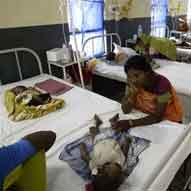This is the VOA Special English Development Report.

Diarrhea kills one and a half million children each year -- one in five child deaths worldwide. The only disease that kills more children under age five is pneumonia.
Experts say diarrhea causes more child deaths than AIDS, malaria and measles combined. New findings show it also kills more than a million adolescents and elderly people every year.
Therese Dooley is a senior adviser at UNICEF, the United Nations Children's Fund.
THERESE DOOLEY: "In addition to the deaths, there's about 2.5 billion -- and I want to emphasize, about 2.5 billion cases of diarrhea among children every year."
But a new report says 60 percent of those in developing countries do not get the recommended treatment. The report, appearing in the Lancet medical journal, is from UNICEF and the World Health Organization. It includes a seven-point plan for countries to use to prevent and treat diarrhea.
The condition causes fluid loss and reduces the body's supply of zinc. This mineral is needed for normal growth and development.
For the past five years, UNICEF and the W.H.O. have recommended zinc supplements to treat diarrhea. They also recommend fluid replacement solutions made from what are called low-osmolarity oral rehydration salts.
Yet zinc supplements remain largely unavailable in the developing world. And the fluid replacement solutions can also be difficult to find.
A leading cause of diarrhea in children is the rotavirus. Public health officials are now advised to include the rotavirus vaccine in all national immunization programs. But the vaccine is still not available in many developing countries.
The report says new ways to expand the use of treatments are now being developed. Proposals include, for example, supplying treatment kits through community health workers or special campaigns.
Experts say children with diarrhea should continue to eat, and babies should continue to breastfeed.
To help prevent diarrhea, the report suggests that children receive both the rotavirus and measles vaccines. It also calls for improving supplies of clean water in developing countries.
Another prevention measure is hand washing with soap.
Diarrhea can be easy to prevent. Campaigns to fight childhood diarrhea had some success during the 1970s and 80s. The authors of the report hope this new plan will help return the issue to worldwide importance.
And that's the VOA Special English Development Report, written by June Simms, and available at voaspecialenglish.com. I'm Bob Doughty.
zinc: a bluish-white, lustrous metallic element that is brittle at room temperature but malleable with heating 锌
low-osmolarity: 摩尔渗透压浓度低的
rehydration: the replenishment of water and electrolytes lost through dehydration 再水化
rotavirus: any of a group of wheel-shaped, RNA-contained viruses that cause gastroenteritis, especially in infants and newborn animals 轮状病毒
immunization: the process of inducing immunity to an infectious organism or agent in an individual or animal through vaccination 免疫化
Related stories:
How do vaccines reach the developing world?
Experts say babies should be fed only breast milk for the first six months
WHO: Millions of children need not die from pneumonia
研究:交通污染会引发儿童过敏疾病
(Source: VOA 英语点津编辑)